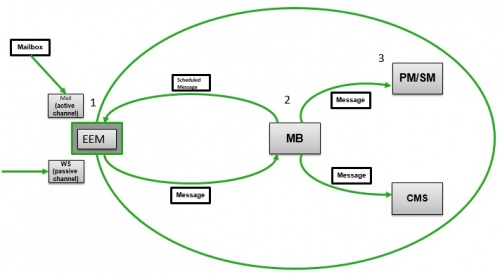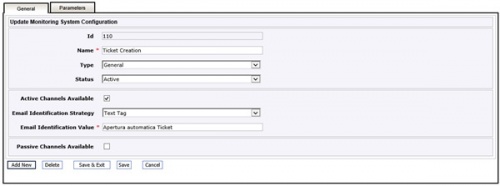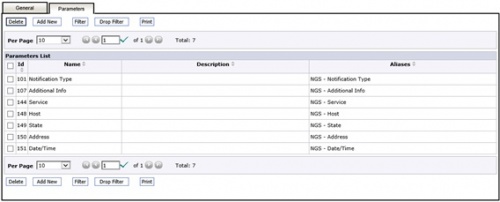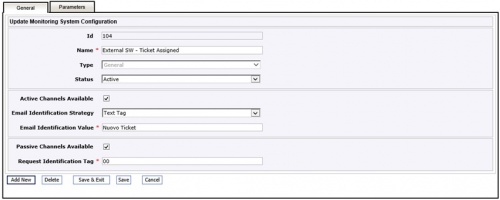Differenze tra le versioni di "EEM - External Event Management"
(→Action Engine Configuration) |
|||
| Riga 104: | Riga 104: | ||
the following images shown the ''[[Glossary|action]]' user interface and provide some more detail about this functionality | the following images shown the ''[[Glossary|action]]' user interface and provide some more detail about this functionality | ||
| + | |||
| + | [[File:Action general tab v1.0.jpg|centre|thumb|500x500px|Action Configuration]] | ||
| + | |||
| + | [[File:Action condition tab v1.0.jpg|centre|thumb|500x500px|Action Configuration]] | ||
| + | |||
| + | [[File:Action task settings tab v1.0.jpg|centre|thumb|500x500px|Action Task Configuration]] | ||
| + | |||
| + | |||
=== Outbound Comunication === | === Outbound Comunication === | ||
Versione delle 15:54, 7 ago 2015
EEM - External Event Manager is one of the complementary modules of itmSUITE®. The module is intended to support the interaction with third parties applications. A set of pre-configured methods are supplied, in particular:
The module can receive information (inbound message) and send information (outbound). EEM can process inbound message in two ways:
Indice
Active channel
EEM verify at regular interval the existence of mail message in a configured mailbox and process then.
EEM forward the received data towards itmSUITE® module sending them to MB (Message Bus) that works as Dispatcher
MB manage the message queue and dispatch towards the subscriber (other 'modules of itmSUITE® as SM/PM, CMS or EEM)
itmSUITE®module received the message and based on the rule configured in Action Engine execute tasks (eg.: Ticket creation, ticket updating , sending notification, ect.)
Outbound notification are managed directly the itmSUITE® modules eg. PM/SM
Passive channel
EEM has a set of Web Services that third parties software can call.
EEM forward the received data towards itmSUITE® module sending them to MB (Message Bus) that works as Dispatcher
MB manage the message queue and dispatch toward the subscriber (other 'modules of itmSUITE® as SM/PM, CMS or EEM)
itmSUITE® module received the message and based on the rule configured in Action Engine execute tasks (eg.: Ticket creation, ticket updating , sending notification, ect.)
Outbound notification are managed directly the itmSUITE® modules eg. PM/SM
Inbound EEM schema
- EEM process and validate all the incoming message
- MB dispatch the message to a subscriber
- itmSUITE® module through Action Engine execute the required task
Inbound Comunication
As mention above, this communication can be managed through:
- Active channel
- Passive channel
The paragraph below shown the main step necessary to configure them.
Active channel
The activity to perform to correctly set up this configuration are:
- Define one or more Active configuration channel
- Implement a validation rule via MSC (Monitoring System Configuration)
Using EEM Menu Active Notification Channels is possible to define the parameter necessary to access, one or more, mailbox.
The image below shown the parameter to insert to configure a mailbox
An MSC (Monitoring System Configuration) is composed by General and Parameter informations.
The image below shown the General tab used by the system to validate the incoming data
The image below shown the Parameter tab used by the system to collect information present on a message.
One message is validated if the Identification Strategy is respected and all the parameters are presents into the body of message
Passive channel
When itmSUITE® is called from third parites system is necessary to define the validation rule using the MSC (monitoring sytem configuration) session.
In this case, a client call is accepted if the Request Identification tag and the expected Parameters are properly passed into the SOAP message.
The image below shown a MSC (monitoring sytem configuration) configuration session.
Action Engine Configuration
When the incoming message is validated by EEM, the informations are sent to MB (Message Bus) that dispatch it to the itmSUITE® Action engine and a configured Action is activated.
Action Engine enabled the user to configured an Action and the activation condition. An action is composed by:
- General Information
- Trigger and Activation condition
- Parameters
- Tasks to execute
the following images shown the action' user interface and provide some more detail about this functionality







